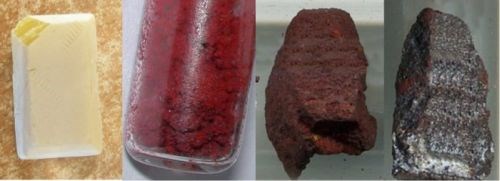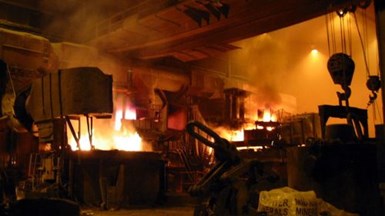Phosphorus - Important to Platers, But More Important to Our Bodies
Phosphorus is important to platers because it is a key component of most electroless nickel deposits which contain about 5-10% (by wt) phosphorus. As far as the human body is concerned, there is no substitute for phosphorus.
by
Jack Dini
Livermore, California, USA

Wikipedia, CC BY-SA 3.0
Editor’s Note: For the second month of the new year, highly-regarded AESF/NASF contributor Jack Dini has provided us with another of his fascinating writings, this time on phosphorus. A printable version of this article can be accessed HERE.
Introduction
Phosphorus is important to platers because it is a key component of most electroless nickel deposits which contain about 5-10% (by wt) phosphorus. This is obtained from hypophosphite which is part of the solution formulation. Non-phosphorus containing electroless nickel solutions do exist, but see limited use compared to those containing phosphorus. As far as the human body is concerned, there is no substitute for phosphorus.
Discovery of phosphorus

The Alchemist Discovering Phosphorus,
by Derby 1771, Public Domain
Phosphorus is the 13th most abundant element in the earth's crust (0.099%), sandwiched between fluorine and manganese.
Perhaps nothing better typifies the strange and often accidental nature of chemical science in its early days than a discovery made by a German named Henning Brand in 1675. Brand became convinced that gold could somehow be distilled from human urine. The similarity of color seems to have been a factor in his conclusion. He assembled fifty buckets of human urine, which he kept for months in his cellar. By various processes, he converted the urine first into a noxious paste and then into a translucent waxy substance. None of it yielded gold, of course, but a strange and interesting thing did happen. After a time, the substance began to glow. Moreover, when exposed to air, it often spontaneously burst into flame.1
What Brand discovered was a new element, phosphorus, the first to be discovered in hundreds of years. It turns out each human excretes a minimum of 1.5 grams of phosphorus in their urine per day, so the annual output is over three billion pounds of phosphate, as phosphorus pentoxide.2
Canadian and Dutch scientists have engineered pigs to secrete an enzyme in their saliva that reduces the polluting phosphorus content of their manure by up to 75%.3 Could the same thing be done with humans? Think of all the phosphorus waste that could be eliminated. Anyhow, this leads to the next topic about phosphorus.
Human body

Phosphorus is one of the most essential minerals that are necessary for the sustenance of human life. As mentioned earlier, in the human body, there is no substitute for phosphorus. No other element possesses the properties to form chains of phosphate esters - the so-called “backbone” of DNA/RNA.4
In various forms, phosphorus is a component of DNA, a player in cellular energy transport, and a building block in cell membranes and bone. The key fuel on which all the rest of our body cellular chemistry depends is adenosine triphosphate (ATP). ATP is the body's primary source of energy for everything from walking to thinking. Every day our bodies synthesize and break down about 3 grams of ATP for every gram of body weight. Four separate Nobel Prizes have been awarded for ATP-related discoveries.5
Table 1 provides information on phosphorus in the human body. Phosphorus is a dietary requirement, the recommended intake being 800 milligrams per day, but it is not something that a person need worry about. Phosphorus is found in high amounts in protein foods, such as milk and milk products and meat and alternatives such as beans, lentils and nuts. Grains, especially whole grains provide phosphorus. Phosphorus is found in smaller amounts in vegetables and fruit. A normal diet provides between 1000 and 2000 milligrams per day, depending on the extent to which phosphate-rich foods are consumed. These include tuna, salmon, sardines, liver, turkey, chicken, eggs and cheese, all of which have more than 200 milligrams per 100 grams.6
Table 1 – Phosphorus in the Human Body*
Blood 345 ppm
Bone 70,000 ppm (7%)
Tissue 3000-8000 ppm (0.3-0.8%)
Total amount in body 780 grams
* John Emsley, Nature's Building Blocks (Oxford, Oxford University Press, 2001); p. 310.
Agriculture

As an essential nutrient in fertilizers, phosphorus ensures the world's agricultural soils are fertile, crop yields are high, farmer livelihoods are supported and ultimately that the global population can be fed.
There is no substitute for phosphorus in food production. Without phosphorus, we cannot produce food. Phosphorus is an essential element for all life, including plants, animals and bacteria. Approximately 90% of all phosphate rock is mined for food production (fertilizers, feed and food additives).
David Vaccari reports, “As complex as the chemistry of life may be, the conditions for the vigorous growth of plants often boils down to three numbers, 19-12-5. Those are the percentages of nitrogen, phosphorus and potassium, prominently displayed on every package of fertilizer. In the 20th century the three nutrients enabled agriculture to increase its productivity and the world's population to grow more than sixfold.”
The Global Policy Research Initiative reports that it is uncertain whether the world's main source of phosphorus will be available and accessible in the future. Phosphate rock is finite and becoming increasingly scarce, expensive and concentrated in only a few countries. Morocco alone controls three-quarters of the world's remaining high-quality phosphate. Some scientists want concern for the world's dwindling phosphorus tacked onto the world's list of environmental hazards with potentially global implications.7
Steel and Henry Bessemer's luck

Henry Bessemer, steel magnate in the late 1800s, developed a process that could make steel in under an hour, rather than weeks. His improvements finally made steel available to large scale engineering projects - a development that, some historians claim, ended the three thousand year old Iron Age in one stroke, and pushed humankind into the Age of Steel.
Excess phosphorus in the English iron ore of the time left most batches brittle and prone to fracturing at cold temperatures. Bessemer was lucky because his initial tests had been on phosphorus-free ore from Wales; otherwise his product would have failed.8
The downside of phosphorus
Too much phosphorus from eroded soil and from human and animal waste ends up in rivers, lakes and oceans, where it spurs massive, uncontrolled blooms of cyanobacteria (also known as green algae) and algae which starve other organisms of oxygen, creating “dead zones” and contributing to the depletion of fisheries.6
The Florida Everglades are clearly the best example of the downside of too much phosphorus. The phosphorus, which comes from fertilizer, sewage and animal wastes, triggers massive harmful algae blooms that foul beaches, kill fish and smother sawgrass. Unnaturally high levels of phosphorus fuel the growth of cattails which force out sawgrass and other natural habitat vital to the survival of the Everglades.8
Phosphorus control programs over the last 20 years have significantly improved Everglades water quality. Florida has invested more than $1.8 billion in water quality improvements aimed at lowering phosphorus levels. Today, as a result of Florida's efforts, concentrations within the Everglades have positively responded and are now at 10 ppb.9
Another example of phosphorus pollution is Lake Erie. In the decades leading up to the 1970s, loadings of nutrients, particularly phosphorus from municipal sewage treatment plants and other anthropogenic sources, visibly degraded Lake Erie. This excessive nutrient enrichment, known as eutrophication, resulted in severe algae fouling of the lake, which in turn created aesthetic, taste and odor problems, reduced available oxygen and led to fish die-offs after a number of years.
Ohio will limit phosphorus into Lake Erie to reduce the harmful algal blooms. The Ohio EPA's draft 2020 water quality report, which every two years outlines the general condition of Ohio's rivers and lakes, says the state will spend two to three years to develop an enforceable limit on the mount of phosphorus that can be dumped into the water.10
Another example of the downsides of phosphorus are human-made organophosphate nerve gases because these bad agents are some of the most poisonous chemicals on earth. Sarin, and other organophosphate neurotoxins, screw up the chemical switch. All nerve agents cause their toxic effects by preventing the proper operation of an enzyme that acts as the body's “off switch” for glands and muscles. Without an “off switch”, the glands and muscles are constantly being stimulated. Sarin can take effect within seconds of being inhaled and symptoms can appear within a minute of exposure. It can be lethal in around 5-10 minutes.4
References
1. Ross Pomeroy, “How urine led to the foundation of chemistry,” realclearscience.com, December 2, 2014.
2. William McGucken, Lake Erie Rehabilitated, University of Akron Press, Akron, Ohio, 2000); p. 75.
3. Serguei P. Golovan, et al., “Pigs expressing salivary phytase produce low-phosphorus manure,” Nature Biotechnology, 19 (8), 741-745 (2001).
4. Josh Bloom, “Phosphorus: life and death. A chemistry lesson from hell,” acsh.org, October 8, 2021.
5. Peter W. Huber and Mark P. Mills, The Bottomless Well, Basic Books, (New York, 2005); p. 184.
6. John Emsley, Nature's Building Blocks Oxford University Press, Oxford, UK, 2001: p. 310.
7. David A. Vaccari, “Phosphorus, A Looming Crisis,” Scientific American, 300 (6), 54-59, (June 2009).
8. Sam Kean, Caesar's Last Breath, Little, Brown and Company, New York, 2017.
9. “Harmful nutrients in the Everglades now reduced by 90%,” sfwmd.gov, accessed October 12, 2021.
10. “After years of pushback, Ohio will limit phosphorus into Lake Erie to reduce harmful algal blooms,” cleveland.com, February 20, 2020.
About the author

Jack Dini earned a Bachelor of Metallurgical Engineering degree from Cleveland State University and began his career in the 1950s with Cleveland Supply Co. (now Pavco). He spent a few years at Republic Steel's research center and Battelle Columbus Laboratories. In 1962, he joined Sandia Laboratories, Livermore, CA, where he was involved with electrodeposition projects for 18 years before moving to Lawrence Livermore (LLNL) in 1980. He was section leader, fabrication processes. Responsibilities included direction of activities in five groups: electroplating and metal finishing, vacuum processes, metal fabrication, plastics and optics.
Mr. Dini is a prolific scientist. He is the author or co-author of some 180 technical papers and, while many researchers are content to specialize in one or two fields, he made significant contributions to more than half a dozen disciplines in surface finishing. He is the author of two books, Electrodeposition- The Materials Science of Coatings and Substrates, and Challenging Environmental Mythology: Wrestling Zeus. The scientific community is fortunate that he carefully documented his work, sharing it with others around the world. It includes plating uncommon metals, alloy plating, printed circuits, chemical milling, electrojoining and gathering electrochemical/property data.
Related Content
Highlights from SUR/FIN 2023
Products Finishing offers a recap of some of the topics that were top of mind at the SUR/FIN 2023 finishing industry trade show.
Read MoreNASF/AESF Foundation Research Project #123: Electrochemical Manufacturing for Energy Applications - 6th Quarter Report
The NASF-AESF Foundation Research Board selected a project on electrodeposition toward developing low-cost and scalable manufacturing processes for hydrogen fuel cells and electrolysis cells for clean transportation and distributed power applications. In this period, work focused on 3D printing anode support for solid oxide fuel cells, SOFC (or cathode for solid oxide electrolyzers, SOEC) based on our designed optimization outlined in the previous report.
Read MoreNASF's SUR/FIN 2023: Bringing the Surface Finishing Industry Together
SUR/FIN 2023 is an opportunity for those in the surface finishing industry to expand their knowledge, expertise and network.
Read MoreNASF/AESF Foundation Research Project #120: Electrochemical Destruction of Perfluorooctanesulfonate in Electroplating Wastewaters – January – December 2023
This NASF-AESF Foundation research project report covers quarterly reporting for the year 2023 at the University of Illinois at Chicago. The objective of this work is to utilize a cost-effective reactive electrochemical membrane (REM) for the removal of PFAS from synthetic electroplating wastewater. Discussed here are the oxidation of PFOA with three different catalysts, development of a method for detecting PFAS, as well as work on 6:2-fluorotelomersulfonic acid (6:2 FTS) and electrodeposited bismuth/tin oxide catalysts.
Read MoreRead Next
Episode 45: An Interview with Chandler Mancuso, MacDermid Envio Solutions
Chandler Mancuso, technical director with MacDermid Envio discusses updating your wastewater treatment system and implementing materials recycling solutions to increase efficiencies, control costs and reduce environmental impact.
Read MoreEducation Bringing Cleaning to Machining
Debuting new speakers and cleaning technology content during this half-day workshop co-located with IMTS 2024.
Read MoreDelivering Increased Benefits to Greenhouse Films
Baystar's Borstar technology is helping customers deliver better, more reliable production methods to greenhouse agriculture.
Read More





















